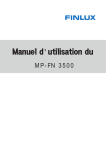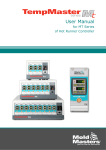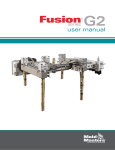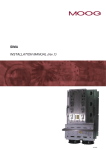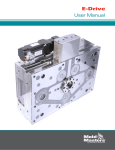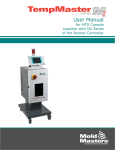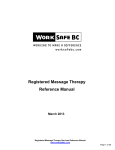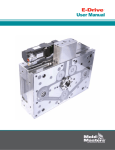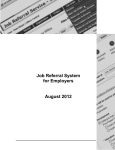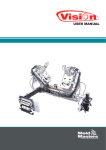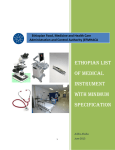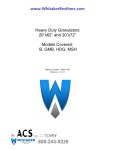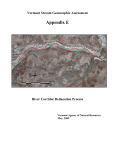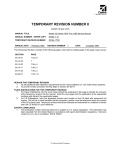Download Hot Runner User Manual - Mold
Transcript
™ Table of Contents Hot Runner User Manual with V2 Valve Bushing www.moldmasters.com ™ Mold-Masters, the Mold-Masters logo, MasterPET and MPET are either trademarks or registered trademarks of Mold-Masters (2007) Limited © 2013. All rights reserved © 2010 Mold-Masters (2007) Limited. All Rights Reserved. Revised Oct 2010 i ™ ™ Table of Contents Table of Contents Section 1 - Introduction...................................................... 1-1 Symbols Used in the Manual................................................................................................ 1-1 Warranty and Documentation............................................................................................... 1-1 Release Details.................................................................................................................... 1-1 MPET™ System Overview - Front....................................................................................... 1-2 MPET™ System Overview - Back........................................................................................ 1-3 MPET™ Nozzle Assembly and Nozzle Tip........................................................................... 1-4 MPET™ V2-Valve Bushing Piston Assembly................................................................................................................... 1-4 Section 2 - Global Support................................................. 2-1 MasterPET™ (MPET™) System Offices.............................................................................. 2-1 Section 3 - Safety................................................................ 3-1 Introduction........................................................................................................................... 3-1 Safety Hazards..................................................................................................................... 3-1 Safety Symbols Typical to Injection Molding Machines........................................................ 3-4 General Safety Warnings..................................................................................................... 3-5 Lockout Safety...................................................................................................................... 3-7 Safety Guards and Interlocks............................................................................................... 3-9 Handling Safety...................................................................................................................3-10 Laying Down Plates or Molds..............................................................................................3-12 Latching...............................................................................................................................3-13 Section 5 - Preparation....................................................... 4-1 Introduction........................................................................................................................... 4-1 Screw Specifications............................................................................................................ 4-1 Tools..................................................................................................................................... 4-1 Recommended Equipment................................................................................................... 4-1 Unpacking............................................................................................................................ 4-2 Cleaning............................................................................................................................... 4-2 Removing Temporary Components......................................................................................................................... 4-2 Machine Checks................................................................................................................... 4-2 Section 5 - Electrical Testing.............................................. 5-1 Introduction........................................................................................................................... 5-1 Wiring Check........................................................................................................................ 5-1 Electrical Safety Testing....................................................................................................... 5-1 Thermocouple Wiring Guidelines......................................................................................... 5-3 Functional Test with a Temperature Controller..................................................................... 5-3 Re-testing............................................................................................................................. 5-3 ™ © 2013 Mold-Masters (2007) Limited. All Rights Reserved. Revised 4 April 2013 i ™ Table of Contents Section 6 - Hot Half Assembly............................................ 6-1 Assembling the Hot Half....................................................................................................... 6-1 Section 7 - System Start Up & Shut Down........................ 7-1 Introduction........................................................................................................................... 7-1 Start-up................................................................................................................................. 7-1 Shut Down............................................................................................................................ 7-1 Section 8 - Maintenance Procedures ................................ 8-1 Introduction........................................................................................................................... 8-1 MPET™ Nozzle Assembly and Nozzle Tip........................................................................... 8-1 MPET™ V2-Valve Bushing Piston Assembly....................................................................... 8-1 Piston Removal.................................................................................................................... 8-2 Valve Stem Removal............................................................................................................ 8-2 New Seal Installation............................................................................................................ 8-3 Re-Installing the Piston........................................................................................................ 8-3 Nozzle Tip Maintenance....................................................................................................... 8-4 Nozzle Tip Removal............................................................................................................. 8-4 Nozzle Tip Installation.......................................................................................................... 8-4 Nozzle Band Heater Removal.............................................................................................. 8-5 Cleaning Nozzle Insulator Cap............................................................................................. 8-6 Checking Nozzle Tip Height................................................................................................. 8-6 Nozzle Band Heater Installation........................................................................................... 8-6 Spare Manifold Thermocouples............................................................................................ 8-7 System Screw Torques......................................................................................................... 8-7 Mold Storage........................................................................................................................ 8-7 Recommended Inspection Schedule.................................................................................... 8-9 Preventative Maintenance and Refurbishment...................................................................8-10 Section 9 - Troubleshooting .............................................. 9-1 Troubleshooting Matrix......................................................................................................... 9-1 ™ © 2013 Mold-Masters (2007) Limited. All Rights Reserved. Revised 4 April 2013 ii ™ Introduction Section 1 - Introduction This manual is intended to provide information for operating and maintaining the MasterPET™ (MPET™) V2 - Valve Bushing Hot Runner, manufactured by Mold-Masters (2007) Ltd. For additional information, please contact your representative or a MPET™ office. Symbols Used in the Manual GENERAL DESCRIPTION OF SYMBOL WARNING Indicates an immediate or potentially hazardous situation, which if not avoided, could result in a serious injury or death. CAUTION Failure to follow instructions may damage equipment IMPORTANT Indicates additional information or used as a reminder Warranty and Documentation Please check with your original order documentation for warranty details. IMPORTANT Please do not return any parts to MPET™ without pre-authorization and a return authorization number supplied by MPET™. Documentation will include one or more of the following: • Parts list of all system components. Together with the general assembly drawing, the parts list should be referenced when ordering spare parts. • Hot half drawing used to integrate hot half to cavity plate. WARNING This manual must be used in conjunction with any appropriate Machine, Mold and Temperature Controller User Manual. When ordering this manual, please reference document number: MPTHHUM_V2_02. Release Details Document # Release Date Version MPTHHUM_V2_02 4 April 2013 02 ™ © 2013 Mold-Masters (2007) Limited. All Rights Reserved. Revised 4 April 2013 1-1 ™ Introduction MPET™ System Overview - Front Leader Pin Electric Box Wire Channel Pry Slot Nozzle Feet ™ © 2013 Mold-Masters (2007) Limited. All Rights Reserved. Revised 4 April 2013 1-2 ™ Introduction MPET™ System Overview - Back Electric Box Lift Holes Mounting Hole Sprue Bushing Feet ™ © 2013 Mold-Masters (2007) Limited. All Rights Reserved. Revised 4 April 2013 1-3 ™ Introduction MPET™ Nozzle Assembly and Nozzle Tip MPET™ V2-Valve Bushing Piston Assembly Seal Assembled Nozzle Screws Piston Spacer Nozzle Nozzle Band Heater Valve Pin Nozzle Tip Insulator Cap Valve Bushing ™ © 2013 Mold-Masters (2007) Limited. All Rights Reserved. Revised 4 April 2013 1-4 ™ Global Support Section 2 - Global Support MasterPET™ (MPET™) System Offices GLOBAL HEADQUARTERS MPET™ N America EUROPEAN HEADQUARTERS MPET™ Europe ASIAN HEADQUARTERS MPET™ Asia SOUTH AMERICAN HEADQUARTERS MPET™ S America MPET™ FRANCE MPET™ JAPAN MPET™ MEXICO MPET™ INDIA Mold-Masters (2007) Limited 233 Armstrong Avenue Georgetown, Ontario Canada L7G 4X5 tel: +1 (905) 877 0185 fax: +1 (905) 873 2818 [email protected] Mold-Masters do Brasil Ltda. Rua Hum, 1106 e 1126 Jd. Manchester - Nova Veneza Sumare - São Paulo Brasil CEP 13178-440 tel: +55 19 3922 4265 fax: +55 19 3922 4266 [email protected] MM Hot Runner Injection México, S.A. de C.V. Av. San Carlos No. 4 – Nave 2 Parque Industrial Lerma Lerma, Estado de México 52000, México tel: +52 728 282 48 33 fax: +52 728 282 47 77 [email protected] Mold-Masters Europa GmbH Postfach/P.O. Box 19 01 45 76503 Baden-Baden, Germany Neumattring 1 76532 Baden-Baden, Germany tel: +49 7221 50990 fax: +49 7221 53093 [email protected] Mold-Masters France ZI la Marinière, 2 Rue Bernard Palissy 91070 Bondoufle tel: +33 1 82 05 00 80 fax: +33 1 82 05 00 83 [email protected] Mold-Masters (KunShan) Co, Ltd Zhao Tian Rd Lu Jia Town, KunShan City Jiang Su Province People’s Republic of China tel: +86 512 86162882 fax: +86 512 86162883 [email protected] Mold-Masters K.K. 1-4-17 Kurikidai, Asaoku Kawasaki, Kanagawa Japan, 215-0032 tel: +81 44 986 2101 fax: +81 44 986 3145 [email protected] Mold-Masters Technologies Private Limited # 247, Alagesan Road, Shiv Building, Saibaba Colony. Coimbatore T. N. India 641 011 tel: +91 422 423 4888 fax: +91 422 423 4800 [email protected] ™ © 2013 Mold-Masters (2007) Limited. All Rights Reserved. Revised 4 April 2013 2-1 ™ Safety Section 3 - Safety Introduction Any instructional material provided by MPET™ Systems for the operation and maintenance of equipment, does not in any way absolve the employer from fulfilling the following obligations and MPET™ Systems disclaims liability for injury to personnel using equipment supplied. It is the responsibility of the employer to: • Ensure the original and continuing competence of personnel caring for, setting up, inspecting and maintaining injection molding equipment. • Establish and follow a program of periodic and regular inspections of injection molding equipment to ensure they are in safe operating condition and proper adjustment. • Ensure that no modifications, repairs, or rebuild of portions are made to the equipment that reduces the level of safety existing at time of manufacture or remanufacture. Safety Hazards The following safety hazards are most commonly associated with plastic injection molding equipment (see European Standard EN201 or American Standard ANSI/SPI B151.1). WARNING Also refer to all machine manuals and local regulations and codes for safety information. 2 (1) Mold area 10 5 3 (2) Clamping mechanism area (3) Area of movement of core and ejector drive mechanisms outside areas 1& 2 (4) Nozzle area (5) Plasticizing and or injection unit area (6) Feed opening area (7) Area of the heater bands of the plasticizing and/or injection cylinders (8) Parts discharge area Top View with Guards Removed Top View with Guards Removed 9 (9) Hoses 1 2 5 4 (10) Area inside the guards and outside the mold area 7 Figure 3-1: Injection molding machine (HIMM) with horizontal clamping unit and horizontal injection unit, shown without guards for illustration clarity. 6 9 8 Front withRemoved Guards Removed Front View withView Guards ™ © 2013 Mold-Masters (2007) Limited. All Rights Reserved. Revised 4 April 2013 3-1 ™ Safety Hazard Area Potential Hazards Mold Area Area between the platens. See Figure 3-1 item 1 Mechanical Hazards Crushing and/or shearing and/or impact hazards caused by: • Movement of the platen Movements of the injection barrel(s) into the mold area Movements of cores and ejectors and their drive mechanisms. • Tie bar motion. Thermal Hazards • Burns and/or scalds due to operating temperature of: • The mold heating elements of the molds. • Plasticized material released from/through the mold. Clamping Mechanism Area See Figure 3-1 area 2 Mechanical Hazards Crushing and/or shearing and/or impact hazards caused by: • Movement of the platen. • Movement of the drive mechanism of the platen. • Movement of the core and ejector drive mechanism. Movement of drive mechanisms outside the mold area and outside the clamping mechanism area. See Figure 3-1 area 3 Mechanical Hazards Mechanical hazards of crushing, shearing and/or impact caused by the movements of: • Core and ejector drive mechanisms. Nozzle area The nozzle area is the area between the barrel and the sprue bushing. See Figure 3-1 area 4 Mechanical Hazards Crushing, shearing hazards, and/or impact hazards caused by: • Forward movement of the plasticizing and/or injection unit including nozzle. • Movements of parts of-the power operated nozzle shutoff and their drives. • Over pressurization in the nozzle. Thermal Hazards Burns and or scalds due to operating temperature of: • The nozzle. • Plasticized material discharging from the nozzle. Plasticizing and/or Mechanical Hazards injection unit area Crushing, shearing and/or drawn into hazards caused by: Area from the adaptor/ • Unintentional gravity movements e.g. for machines with plasticizing and/or injecbarrelhead/end cap tion unit positioned above the mold area. to the extruder motor • The movements of the screw and/or the injection plunger in the cylinder accesabove the sled including sible through the feed opening. the carriage cylinders. • Movement of the carriage unit. See Figure 3-1 area 5 Thermal Hazards Burns and or scalds due to operating temperature of: • The plasticizing and/or injection unit. • The heating elements e.g. heater bands. • The plasticized material and/or vapors discharging from the vent opening, feed throat or hopper. Mechanical and/or Thermal Hazard Hazards due to reduction in mechanical strength of the plasticizing and/or injection cylinder due to overheating. ™ © 2013 Mold-Masters (2007) Limited. All Rights Reserved. Revised 4 April 2013 3-2 ™ Safety Hazard Area Potential Hazards Feed Opening See Figure 3-1 area 6 Pinching and crushing between injection screw movement and housing. Area of the heater bands of the plasticizing and/or injection cylinders See Figure 3-1 area 7 Burns and or scalds due to operating temperature of: • The plasticizing and/or injection unit. • The heating elements e.g. heater bands. • The plasticized material and/or vapors discharging from the vent opening, feed throat or hopper. Parts Discharge Area See Figure 3-1 area 8 Mechanical Hazards Accessible Through the Discharge Area Crushing, shearing and/or impact hazards caused by: • Closing movement of the platen Movements of cores and ejectors and their drive mechanisms. Thermal Hazards Accessible Through the Discharge Area Burns and or scalds due to operating temperature of: • The mold. • Heating elements of the mold. • Plasticized material released from/through the mold. Hoses See Figure 3-1 area 9 • Whipping action caused by hose assembly failure. • Possible release of fluid under pressure that can cause injury. • Thermal hazards associated with hot fluid. Area Inside the Guards Crushing and/or shearing and/or impact hazards caused by: and Outside the Mold • Movement of the platen. Area • Movement of the drive mechanism of the platen. See Figure 3-1 area 10 • Movement of the core and ejector drive mechanism. • Clamp opening movement. Electrical Hazards • Electric shock or burns due to contact with live conductive parts. • Electrical or electromagnetic disturbance generated by the motor control unit. • Electrical or electromagnetic disturbance that can cause failures in the machine control systems and adjacent machine controls. • Electrical or electromagnetic disturbance generated by the motor control unit. Hydraulic Accumulators High pressure discharge. Power Operated Gate Crush or impact hazards caused by the movement of the power operated gates. Vapors and Gases Certain processing conditions and or resins can cause hazardous fumes or vapors. ™ © 2013 Mold-Masters (2007) Limited. All Rights Reserved. Revised 4 April 2013 3-3 ™ Safety Safety Symbols Typical to Injection Molding Machines GENERAL DESCRIPTION OF SYMBOL General – Warning Indicates an immediate or potentially hazardous situation, which if not avoided, could result in a serious injury or death. Warning – Barrel cover grounding strap Lockout/Tagout procedures must be followed before removing the barrel cover. Barrel cover can become energized upon removal of grounding straps and contact can result in death or serious injury. Grounding straps must be reconnected before reconnecting power to machine. Warning – Crushing and/or impact points Contact with moving parts can cause serious crushing injury. Always keep guards in place. Warning – Crush hazard closing mold Warning – Hazardous voltage Contact with hazardous voltages will cause death or serious injury. Turn off power and review electrical schematics before servicing equipment. May contain more than one live circuit. Test all circuits before handling to make sure circuits have been de-energized. Warning – High pressure Overheated fluids may cause severe burns. Discharge pressure before disconnecting water lines. Warning – High pressure accumulator Sudden release of high pressure gas or oil can cause death or serious injury. Discharge all gas and hydraulic pressure before disconnecting or disassembling accumulator. Warning – Hot surfaces Contact with exposed hot surfaces will cause serious burn injury. Wear protective gloves when working near these areas. Mandatory – Lockout/Tagout Ensure that all energies are properly locked out, and remain locked out until the service work is completed. Servicing equipment without disabling all internal and external power sources can cause death or serious injury. De-energize all internal and external power sources (electrical, hydraulic, pneumatic, kinetic, potential, and thermal). Warning – Molten material and/or high pressure gas Molten material or high pressure gas can cause death or severe burns. Wear personal protective equipment while servicing the feed throat, nozzle, mold areas, and when purging the injection unit. ™ © 2013 Mold-Masters (2007) Limited. All Rights Reserved. Revised 4 April 2013 3-4 ™ Safety GENERAL DESCRIPTION OF SYMBOL Warning – Read manual before operation Personnel should read and understand all instructions in the manuals before working on equipment. Only properly trained personnel should operate the equipment. Warning – Slip, Trip, or Fall Hazard Do not climb on equipment surfaces. Serious slip, trip, or fall injuries can result from personnel climbing on equipment surfaces. Caution - Failure to follow instructions may damage equipment Important - Indicates additional information or used as a reminder General Safety Warnings The equipment supplied is subjected to high injection pressures and high temperatures. Ensure that extreme caution is observed in the operation and maintenance of the injection molding machines. • Only fully trained personnel should operate or maintain equipment. • Do not operate the equipment with unconfined long hair, loose clothing or jewelry, including name badges, neckties, etc. These may get caught in the equipment and can cause death or serious injury. • When necessary, wear heat-resistant personal protective equipment (PPE) to prevent burns from contact with hot surfaces or splatter of hot plastic and gases. • It is highly recommended that all operators wear face shields and use heat resistant gloves when working around the feed throat, purging the machine or cleaning the gates of the mold. • Remove purgings from the machine immediately. • Ensure proper ventilation and exhaust systems are in place to help prevent inhalation of harmful gases and vapors. • Consult manufacturer's Material Safety Data Sheets (MSDS). • Follow good housekeeping procedures and keep floors clean to prevent slips, trips and falls due to spilled pellets on the work floor. • • • • • Apply engineering controls or hearing conservation programs as necessary to control noise. Never disable or bypass a safety device. High voltage and amperage cables are connected to the controller (220/240 VAC). Unplug from the controller before performing any maintenance work. High voltage and amperage cables are connected to the mold. Electric power must be shut off and lockout/tagout procedures followed prior to installing or removing any cables. • All maintenance should be performed by properly trained personnel based on local law or regulation requirements. Electrical products may not be grounded when removed from the assembled or normal operating condition. ™ © 2013 Mold-Masters (2007) Limited. All Rights Reserved. Revised 4 April 2013 3-5 ™ Safety • Ensure proper grounding of all electrical products before performing any maintenance to avoid potential risk of electrical shock. • Do not mix electrical power cables with thermocouple extension cables. They are not designed to carry the power load or list accurate temperature readings in each other’s application. • Hoses fitted to the mold will contain high or low temperature fluids or air under high pressure. The operator must shut down and lockout these systems as well as relieving any pressure before performing any work with these hoses. • Regularly inspect and replace all flexible hoses and restraints. • Never perform any work on the mold machine unless the hydraulic pump has been stopped. • Water and/or hydraulics on the mold may be in close proximity to electrical connections and equipment. Water leakage may cause an electrical short circuit. Hydraulic fluid leakage may cause a fire hazard. Always keep water and /or hydraulic hoses and fittings in good condition to avoid leaks. • Check frequently for possible oil leaks / water leaks. Stop the machine and make repairs. • Ensure that mold lifting equipment (eyebolts, fork lift truck, cranes, etc.) will have sufficient capacity to handle mold and hot runner weight. • Check that all coolant, hydraulic and air lines as well as electrical cables will not interfere with the moving parts of the mold, machine or robot. The lines must be of sufficient length so that they will not strain or pinch when the mold halves separate. • For water-cooled gate inserts, coolant must be maintained with the proper mixture to prevent corrosion and circuit blockage. • Care must be taken to ensure the nozzle terminal ends do not come in contact with the water / hydraulic fluid. The nozzles may short out or become damaged. ™ © 2013 Mold-Masters (2007) Limited. All Rights Reserved. Revised 4 April 2013 3-6 ™ Safety Lockout Safety Often power sources are inadvertently turned on, or valves opened mistakenly before the work is completed, resulting in serious injuries and fatalities. Therefore, it is important not only to ensure that all energies are properly locked out, but also that they remain locked out until the work is completed. If a lockout is not performed, uncontrolled energies could cause: • Electrocution (contact with live circuits) • Cuts, bruises, crushing, amputations, death, resulting from entanglement with belts, chains, conveyors, rollers, shafts, impellers • Burns (contact with hot parts, materials, or equipment such as furnaces) • Fires and explosions • Chemical exposures (gases or liquids released from pipelines) Energy Forms, Energy Sources, and General Lockout Guidelines Electrical Energy Power transmission lines; Machine power cords; Motors; Solenoids; Turn off power at machine first (i.e., at point of operation switch), and then at the main disconnect switch for the machine; lock and tag main disconnect switch Capacitors (stored electrical energy) Fully discharge all capacitative systems (e.g., cycle machine to drain power from capacitors) according to manufacturer’s instructions Hydraulic Energy Hydraulic systems (e.g., hydraulic presses, rams,cylinders, hammers) Shut off, lock (with chains, builtin lockout devices, or lockout attachments) and tag valves; bleed off and blank lines as necessary. Pneumatic Energy Pneumatic systems (e.g.,lines, pressure reservoirs, accumulators, air surge tanks, rams, cylinders) Shut off, lock (with chains, built-in lockout devices, or lockout attachments) and tag valves; bleed off excess air; if pressure cannot be relieved, block any possible movement of machinery. Kinetic Energy (Energy of a moving object or materials moving object may be powered or coasting) Stop and block machine parts (e.g. stop flywheels and ensure that they do not recycle); review entire cycle of mechanical motion, ensure that all motions are stopped. Blades; Flywheels; Materials in supply lines Block material from moving into area of work; blank as required. ™ © 2013 Mold-Masters (2007) Limited. All Rights Reserved. Revised 4 April 2013 3-7 ™ Safety Energy Forms, Energy Sources, and General Lockout Guidelines Potential Energy Thermal Energy (Stored energy that an object has the potential to release due to its position) springs (e.g., in air brake cylinders); actuators; counterweights; raised loads; top or movable part of a press or lifting device If possible, lower all suspended parts and loads to the lowers (rest) position, block parts that might be moved by gravity; release or block spring energy. Supply lines; Shut off, lock (with chains, builtin lockout devices, or lockout attachments) and tag valves; bleed off excess liquids or gases; blank lines as necessary. Storage tanks and vessels Electrical Lockout Employers must provide an effective Lockout/Tagout program. Refer to all machine manuals and local regulations and codes. 1. Shut down machine using normal operational shutdown procedure and controls. This should be done by, or in consultation with the machine operator. 2. After ensuring that the machinery has been completely shut down, and all controls in the “off” position, open the main disconnect switch located in the field. 3. Using your own personal padlock, or one assigned by your supervisor, lock the disconnect switch in the off position. Do not lock only the box. Remove the key and retain. Complete a lockout tag and affix to the disconnect switch. Each person working on the equipment must follow this step. The lock of the person doing the work or in charge must be installed first, remain throughout and be removed last. Test the main disconnect switch and make sure it cannot be moved to the “on” position. 4. Try to start the machine using the normal operation controls and point of operation switches to make sure that the power has been disconnected. NOTE In some instances, there may be more than one power source feeding equipment and steps must be taken to ensure that all sources are effectively locked out. 6. When the work is completed, prior to removing the last lock, make sure the operational controls are in the “off” position so that the main disconnect switching is done under “no load”. Ensure all blocks, tools and other foreign materials are removed from machine. Also ensure that all personnel that may be affected are informed that the lock(s) will be removed. 7. Remove lock and tag, and close the main disconnect switch if permission has been given. 8. When the work has not been completed on the first shift, the next operator should install a personal lock and tag before the first operator removes the original lock and tag. If the next operator is delayed, a lock and tag could be installed by the next supervisor. Lockout procedures should indicate how the transfer is to be conducted. 9. It is important that, for their personal protection, each worker and/or foreperson working in or on a machine places his/her own safety lock on the disconnect switch. Use tags to spotlight work in progress and give details of work being done (see figure 2). Only when the work is completed and the work permit signed off, may each worker remove his/her lock. The last lock to be removed should be that of the person supervising the lockout and this responsibility should not be delegated. © Industrial Accident Prevention Association, 2008. 5. Other sources of energy that could create a hazard while working on the equipment must also be deenergized and appropriately “locked-out”. This can include gravity, compressed air, hydraulics, steam and other pressurized or hazardous liquids and gases (see table below). ™ © 2013 Mold-Masters (2007) Limited. All Rights Reserved. Revised 4 April 2013 3-8 ™ Safety Safety Guards and Interlocks Plastic injection machines require guards to protect employees from nip points, numerous moving parts, and exposure to high voltage and high temperature. WARNING Serious injuries including fatalities, amputations, avulsions, burns, cuts, and bruises can occur during operation if guards are missing, improperly installed, removed, or bypassed. Never purposefully reach around, under, or over guards into hazardous areas. Types of Guards Method Safeguarding Action Fixed (Not Interlocked) Provides a barrier Moveable (Interlocked) Shuts off or disengages power and prevents starting of machine when guard is open; should require the machine to be stopped before the worker can reach into the danger area It is important to ensure that: Do not remove, alter, or attempt to otherwise bypass a safety interlock. • Safety guards are tested and inspected regularly for correct operation. Never access the mold cavity via the operator's gate and do not remove a fixed guard during normal operation. • Operators and maintenance workers are trained in location of equipment safeguards, how they provide protection, and what hazards they protect against. • Operators and maintenance workers are trained in how and under what circumstances guards can be removed. • Operators and maintenance workers are trained in the location of emergency stops. Never rely on interlocks rather than lockout/tagout procedures. ™ © 2013 Mold-Masters (2007) Limited. All Rights Reserved. Revised 4 April 2013 3-9 ™ Safety Handling Safety WARNING The use of improper material handling equipment can cause injury or death. Ensure all equipment, including cranes, chains, slings, eye bolts and lift rings are rated to the required load. It is the responsibility of the employer to: • Ensure the original and continuing competence of personnel operating material handling equipment including rigging, inspecting and using equipment. • Establish and follow a program of periodic and regular inspections of material handling equipment to ensure they are in safe operating condition. • Ensure all material handling equipment, including cranes, chains, slings, eye bolts and lift rings are rated to the required load. General Safety When Lifting a Load 1. Define the Load Path (the path and orientation the item will move in while it is being lifted, and the location and orientation where it will be set down). 2. Choose lift equipment that is rated for the prescribed load. 3. Identify the characteristics (center of gravity, physical dimensions, weight, lifting points, etc.) of the object(s) being lifted. 4. Know the rigging requirements before the lift is performed. (If unsure of the rigging requirements, contact the Hoisting and Rigging Inspector or Plant Engineering Rigging Supervisors). 5. Identify and avoid potential pinch points (where an individual or a component of the lifting equipment or load may be caught between two surfaces). 6. Consider load balance, load configuration, dimensions and attachment points. 7. Never replace or modify a manufactured lifting component (for example, a shackle pin with a bolt in an eyebolt assembly). 8. Keep shackles straight for maximum capacity. (In effect, prevent the load, as applied to the shackle, from creating an eccentric force or bending moment on the shackle body.) Under certain conditions, this type of loading may cause the legs of the shackle to open up. WARNING Please inform MPET™ Systems immediately if interfacing an 'other than supplied' mold cold half or hot half as this will impact the weight of the mold and therefore lift bars, latches and mold mounting. ™ © 2013 Mold-Masters (2007) Limited. All Rights Reserved. Revised 4 April 2013 3-10 ™ Safety 9. Know the intended use of the eyebolts when they are supplied as part of the equipment. It is possible that they may only have intended to lift part of the mold/equipment. lifting eyebolt lift bar screw 10. Secure and balance the load in the chain or lifting device before it is lifted more than a few inches. 11. Minimize swinging by bringing the hook over the load appropriately. 12. Stand clear of the suspended load at all times. mold 13. Use shoulder eyebolts only, and de-rate them accordingly, depending on the angle (angle of the load path) of the corresponding connecting sling or wire rope. bail Hoist Ring and Eyebolt Safety Always inspect hoist ring before use. Make sure: • The screw is tightened to recommended torque. • The bushing sits flush against object being lifted. • Hoist ring is free to swivel and pivot in evey direction. • There are no signs of corrosion, wear or cracks, especially on the screw, shoulder pins and bail. • The shoulder pins are secure and do not rotate or come loose. washer shoulder pin Ensure hoist rings and eyebolts are used at correct lift angle (see examples below). body bushing screw 90° 0° RIGHT RIGHT WRONG RIGHT RIGHT WRONG WRONG WRONG ™ © 2013 Mold-Masters (2007) Limited. All Rights Reserved. Revised 4 April 2013 3-11 ™ Safety Laying Down Plates or Molds 1. Align a wooden block under the plate or mold at the side opposite to where the plate or mold is to be laid down. As required, insert wooden blocks under plates or mold to prevent any damage to components on underside and to ensure stable horizontal orientation. 2. Slowly lower the plate or mold onto the wooden block. Wooden Block 3. Slowly lower the plate or mold downward onto the work bench or surface. 4. Move the crane so that the chain or sling maintains a vertical orientation. Picking Up Plates or Molds WARNING U se a block of wood when raising the plates or mold to prevent the load from tipping over the opposite way which could cause bodily harm. ift the plate or mold slowly off the L wooden block to minimize any swinging or pendulum motion that could cause bodily harm. 1. Align a wooden block under edge of plate or mold. 2. Lift the plate or mold off the workbench onto the wooden block. 3. Slowly lift the plates or mold off the bench. ™ © 2013 Mold-Masters (2007) Limited. All Rights Reserved. Revised 4 April 2013 3-12 ™ Safety Latching WARNING Make sure the lifting eyebolt, lifting chain and crane are rated to adequately support the weight of the plate(s). Failure to do so can cause a serious injury. Introduction There are two reasons latches are used in a mold: • To tie the mold halves together for transportation and handling, • To gain access between two mold plates which are screwed together during normal mold operation. 5. If the mold has no leader pins, attach a crane that is rated to adequately support the weight of the cavity plate. Latches are always used in pairs mounted on diagonally opposite sides of the mold to provide equal pull on the plates. WARNING Install latches before removing the cavity plate mounting screws. Failure to do so may lead to serious injury or death. The latches are located on: • The operator’s side, • Non-operator’s side of the mold, or • Top and bottom of the mold. 6. Latch the cavity plate to the manifold or manifold backing plate. Under no circumstances are plates to be pulled or handled with only one latch attached. 1 Latch locations are shown on the assembly drawings. During mold operation the latches must be removed from the mold and stored elsewhere. 2 Latching the Cavity Plate to the Core Half (Cold Half) 3 Use this procedure for reference purposes only. For latch locations, refer to the assembly drawings. For additional instructions on latching in the machine refer to the machine manufacturers manual. 1 WARNING Make sure the machine has been locked out and tagged out in accordance to the machine's documented procedures. Failure to do so may lead to serious injury or death. 1. Open the mold. 2. Check the machine and hot runner controller has been locked out and tagged out. Refer to the controller and machine manufacturers documentation for procedures. 3. Apply lockout / tagged out to the machine power source and hot runner controller. Refer to the controller and machine manufacturers documentation for procedures. 4. Allow the mold to cool to room temperature. Continue to circulate the mold cooling water in all plates to cool the mold faster. Latch Cavity Plate to Manifold Plate 1. Latches 2. Manifold Plate 3. Cavity Plate 7. Check that the cavity plate hoses are long enough to allow the cavity plate to be latched over to the core half (cold half), without damaging the hoses. 8. Remove all cavity plate mounting screws. 9. Remove lockout / tagged out. 10. Place the machine in Mold Set mode. 11. Close the mold slowly. WARNING Make sure the machine has been locked out and tagged out in accordance to the machines documented procedures. Failure to do so may lead to serious injury or death. ™ © 2013 Mold-Masters (2007) Limited. All Rights Reserved. Revised 4 April 2013 3-13 ™ Safety 12. Apply lockout / tagged out. Refer to machine manufacturers documentation for procedures. 3 2 13. Remove the latches. 14. Latch the cavity plate to the core plate or cold half. 15. Remove lockout / tagged out. 1 5 4 16. Check the machine is in Mold Set mode. 17. Open the mold moving the cavity plate away from the manifold plate. 18. Apply lockout / tagged out. Refer to the controller and machine manufacturers documentation for procedures. 2 Cavity Plate to Core Plate 1. Stationary Platen 2. Latches 3. Moving Platen 4. Core Plate 5. Cavity Plate Latching the Cavity Plate to the Manifold Plate (Hot Half) WARNING 1 3 Make sure the machine has been locked out and tagged out in accordance to the machines documented procedures. Failure to do so may lead to serious injury or death. 4 2 CAUTION The nozzles must be within 300°F (150°C) of mold temperature to prevent damage to hot runner and mold components. For cylindrical valve gated systems, valve pins should be in the open position prior to removal of the cavity plate to prevent damage. Latch Cavity Plate to Core Plate 1. Stationary Platen 2. Cavity Plate 3. Moving Platen 4. Core Plate 1. Check the machine is locked out / tagged out. 9. Remove lockout / tagout. 2. Lubricate the guide pins on the hot half. 10. Open the mold. 3. Remove lockout/tagout. 11. Check the machine has been locked out / tagged out. Refer to the controller and machine manufacturers documentation for procedures. 4. Check the machine is in slow speed (Mold Set) mode. 5. Slowly close the mold. 6. Check the machine has been locked out / tagged out. Refer to the controller and machine manufacturers documentation for procedures. 7. Remove the latches on both sides of the mold. 12. Install and torque the cavity plate mounting bolts. Torque to required specifications, refer to assembly drawings for required torque settings. 13. Install hoses if required. 14. Remove latches from both sides of the mold. 8. Latch the cavity plate to manifold plate or manifold backing plate. ™ © 2013 Mold-Masters (2007) Limited. All Rights Reserved. Revised 4 April 2013 3-14 ™ Preparation Section 5 - Preparation Introduction The following section is a step-by-step guide to preparing your MPET™ System for use. Screw Specifications WARNING he use of an incorrect size, length and grade screw could cause the screw to shear, fatigue or T stretch beyond its yield point, resulting in expensive downtime of the hot runner. Be aware of warnings placed on the assembly drawings. When the manifold is heated the metal expands stretching the mounting screws, if screw lengths are shortened there is a possibility of shearing. The expansion factor is calculated into the length of each screw size. Tools Depending on the size and complexity of your MPET™ System, you will require most of the tools and materials listed below. • Allen keys - Set of imperial size keys and metric sizes for use on both imperial and metric cap screws (depending on system • Anti-seize compound - To prevent oxidation of screw threads that could cause screws to seize with high temperatures • • • • • • • • • • • • • Calibrated torque wrench and adjustable wrenches Hex head socket driver Pry Bars Feeler Gauges Bluing Compound - For checking face contact Sockets Plastic / brass face hammer Brass bristle wire brush Brass scrapers Grease gun Flashlight Eyebolt Inspection mirror Recommended Equipment Must meet weight requirements: • Work Bench • Crane • Test controller suited for mold requirements ™ © 2013 Mold-Masters (2007) Limited. All Rights Reserved. Revised 4 April 2013 4-1 ™ Unpacking 1. Carefully remove components from the shipping container and check that all components listed on the packing slip were supplied. 2. Check that all mold base dimensions are correct and correspond to MPET™ Systems general assembly drawings. Preparation Removing Temporary Components Any temporary components that are needed for moving and lifting (latches, lift bars, etc.) are all marked in YELLOW and must be removed before using the hot runner for production. CAUTION Failure to remove these temporary components before production will damage the mold or machine. Cleaning WARNING 1. Carefully remove any rust inhibitor that has been applied to the system to avoid contamination of food packaging mold. Any components marked in red are essential safety components that MUST NOT be removed. Machine Checks 1. Check machine is level and if necessary adjust per machine manual. Clamp Area 2. With mold open and leader pin not engaged, check machine parallelism and if necessary adjust per machine manual. 1 3. With mold closed but not in clamp-up, check machine parallelism and if necessary adjust per machine manual. Mold Area Operator Side 3 5 2 6 4 Check Machine Level 6 checks CAUTION Failure to ensure machine is level and parallel could result in damage to mold or machine. 1 2 Clamp Area Mold Area Operator Side 3 4 Check Machine Parallel 4 checks ™ © 2013 Mold-Masters (2007) Limited. All Rights Reserved. Revised 4 April 2013 4-2 ™ Electrical Testing Section 5 - Electrical Testing Introduction This section contains guidelines for electrical testing of your MasterPET™ (MPET™) System system. The testing is based on the following European and North American standards: EN 60204-1 / DIN EN 60204-1 (IEC 60204-1, modified) Safety of machinery - electrical equipment of machines NFPA 79 Electrical Standard for Industrial Machinery The standards themselves are the final authority for testing requirements (also any additional testing requirements from any national standards where the hot runner is in use). WARNING The user is responsible to ensure protection against shock by indirect contact, by protective earth conductors and automatic disconnection of supply. MPET™ components and systems are either equipped with a protective earth conductor or there is a connector for this purpose. WARNING To avoid serious burns wear safety clothing consisting of a protective heat-resistant coat, heat-resistant gloves and a full face shield over safety glasses. Use adequate ventilation for fumes. ontact with heated components may C cause serious burns. Use a sign in a visible location indicating “Danger: Do Not Touch”. Before you carry out electrical work, make sure that the hot runner system is securely grounded. Turn the temperature control off and disconnect all electric wires coming from the mold. Failure to follow of these steps may lead to serious injury or death. Wiring Check WARNING Ensure that all wiring and connection work is performed by a qualified electrician according to DIN EN 60204-1 / NFPA79. 1. Check that each wire and thermocouple has a zone number. 2. Check that wires are organized and taped together by zone and plug. WARNING A disassembled nozzle should only be connected to an electrical supply when the nozzle has been grounded or a safety isolating transformer is used. Electrical Safety Testing Electrical safety tests shall be performed according to DIN EN 60204-1, paragraph 18 and NFPA79. Testing guidelines are given below, however, the standards identified earlier in the introduction are the final authority. Verify Equipment to its Technical Documentation First, verify that the electrical equipment complies with its technical documentation. Insulation Resistance Test Measure the insulation resistance between each pin of the MPET™ power connector, in particular the heating circuit and ground. The insulation resistance is measured at a DC voltage of 500V. The insulation resistance must not be less than 1 MΩ. If this value is not reached when heating, the cause is often moisture inside the heating element, which should be removed using a control unit equipped with this function. Where a mold has not been in use for several weeks or months, it should be re-tested. Verification of Conditions for Protection by Automatic Disconnection of Supply WARNING 3. Check all wires are secured in wire channels. The user is responsible to take protective measures against shock by indirect contact, while performing the tests. 4. Connect all power leads and thermocouple wires to mold plugs. 5. The electricity mains should only be connected to the injection mold when all electrical connections are grounded and the mold is closed. ™ © 2013 Mold-Masters (2007) Limited. All Rights Reserved. Revised 4 April 2013 5-1 ™ Electrical Testing The conditions for automatic shutdown of the supply is set at the MasterPET™ facility and is usually set such that the protective conductor resistance between the grounding conductor connection and all of the protective earth conductor connected parts, is Maximum 0.3 Ω. 2 1 In TN systems the following two checks must be made: Test 1 - Verifies the continuity of the protective bonding circuit The purpose of this test is to check whether all relevant touchable conductive parts are properly grounded. See the relevant requirements of the standard DIN EN 60204-1/ NFPA79. Figure 6-1 Mold Plug 1. Mold Power Connector 2. Thermocouple Connector The protective conductor resistance is measured with a special instrument with a current between at least 0.2 A and approximately 10 A derived from an electrically separated supply source (for example SELV, see 413.1 of IEC 60364-4-41) having a maximum no-load voltage of 24 V AC or DC. 2. To verify alignment of thermocouple in the heating element, turn on one zone after the other and check that the temperature responds accordingly if the set temperature is adjusted. The resistance should be within the expected range. Pinch Point Test Test 2 - Fault loop impedance verification and suitability of the associated overcurrent protective device The power supply connections and incoming external grounding connections to the hot runner system (usually through a temperature control device), must be verified by inspection. The conditions for protection by automatic disconnection of supply must be checked by both: (1) Checking the impedance of the fault loop by calculaton or measurement. (2) Confirming that the setting and characteristics of the associated overcurrent protective device are in accordance with the requirements of the standard. For more information, see the text of the EN 60204-1/ NFPA79 standards. Thermocouple Continuity Test be between 2.5 Ω and 25 Ω. 1. If there is a suspected pinch point on the thermocouple, remove the thermocouple from the hot runner. 2. Connect a temperature control device to read the temperature. 3. Immerse the sheath of the thermocouple in boiling water to the point where the thermocouple reads the temperature. 4. A good thermocouple will show a temperature rise as soon as the tip of the thermocouple is immersed in water. If there is a pinch point in the thermocouple there will be no change in the reading until the pinch point on the thermocouple is immersed in water. Heating Element Check Measure the resistance between each pair of heater power wires at the mold power connector. Compare your reading with your general assembly drawing. Where: R = resistance U = voltage R= 1. Measure the resistance between each pair of thermocouple wires and the mold’s thermocouple connector. (See Figure 6-1). The resistance should P = power U² P ™ © 2013 Mold-Masters (2007) Limited. All Rights Reserved. Revised 4 April 2013 5-2 ™ Electrical Testing Thermocouple Wiring Guidelines • Thermocouples are Type "J" ungrounded and color coded to ASA standards. (White “+”/Red “- “). • The tip must not be truncated or squeezed and must touch the bottom of the bore in order to measure the correct temperature. • Each heat source should have its own closed loop temperature control in order to achieve accurate control. • If there are not enough control zones, heat sources that have the same wattage and affect the same environment, may be grouped together. CAUTION Exceeding controller zone amperage will cause controller fuses to blow. Functional Test with a Temperature Controller The functions of the electrical equipment must be checked. This test is carried out with an appropriate temperature control device. • Monitor the initial heating of the system to minimize risk. • Never start the heating with more than 40% of power. • Stay a minimum of 5 minutes at 212°F (100°C) before increasing heat. Re-testing Where a portion of the electrical equipment is changed or modified, that portion must be re-verified and retested, as appropriate. ™ © 2013 Mold-Masters (2007) Limited. All Rights Reserved. Revised 4 April 2013 5-3 ™ Hot Half Assembly Section 6 - Hot Half Assembly Assembling the Hot Half 1. Check that the nozzle well depth (L) in the cavity plate is to MasterPET™ (MPET™) System specifications. 8. Latch the hot half to the cold half. 2 L 7. Attach a crane that is rated to adequately support the weight of the mold (cold half). 1 3 Nozzle Depth 1. Nozzle Well Depth (L) 2. Cavity Plate 3. Manifold Plate WARNING M ake sure the machine has been locked out and tagged out in accordance to the machines documented procedures. Failure to do so may lead to serious injury or death. 9. Refer to machine manufacturers documentation for operating procedures. 10. Install the mold into the molding machine. 11. Torque the mold mounting screws to required specifications. 12. Connect wire lines, hydraulic, pneumatic and electrical components. 13. Remove latches. WARNING M ake sure the lifting eyebolt, lifting chain and crane are rated to adequately support the weight of the plate(s). Failure to do so can cause a serious injury. CAUTION Potential pinch point. Ensure that all wires are in the retainer grooves. Failure to do so can cause lost production due to hot runner down time. For valve gated systems it is recommended to have the pins in the open position to reduce the possibility of damage. 2. Attach a crane that is rated to adequately support the weight of the cavity plate. 3. Protect the nozzle tip before installing the cavity plate to the manifold plate. 4. Prepare the cavity plate for assembly. 5. Install the cavity plate to the manifold plate. If the plates are not assembling easily, remove the cavity plate and check for interference. 6. Install the mounting screws and torque to required specifications. ™ © 2013 Mold-Masters (2007) Limited. All Rights Reserved. Revised 4 April 2013 6-1 ™ System Start Up & Shut Down Section 7 - System Start Up & Shut Down Introduction This procedure explains how to start up and shut down your MasterPET™ (MPET™) System. CAUTION IMPORTANT Failure to follow the above procedure may result in leakage / damage occurring in the hot runner. nsure the machine nozzle orifice matches E or at most is 1.0 mm (0.040”) smaller than melt entrance for the hot runner system. AUTION C If, for any reason, plastic has not been injected for 20 minutes, the Manifold Heats should be put in Stand-by Mode 180°C (350°F) manifold and nozzles at 22% power). Failure to do so can result in degradation of the PET which can lead to burnt material in the parts and/or damage to the hot runner system. CAUTION heck that the system is heated to processC ing temperature before actuating the valve pins. Failure to do so could cause damage to the valve pins. Start-up WARNING Take appropriate safety precautions by assuming the system is pressurized and hot at all times. Failure to do so can result in a serious injury or death. 1. Turn on the mold cooling and ensure flow is correct. 2. Ensure all mold surfaces are clean and free of plastic debris. 3. Ensure the correct valve gate air pressure is present. Shut Down 1. Shift pins to closed position. 2. If system downtime is expected to be less than half an hour, switch mold heats to stand-by mode 180°C (350°F). Set nozzles to 20% power. If system downtime is expected to be more than half an hour, turn all manifold and nozzles Off. 3. When the Hot Runner temperature is below 100°C (212°F), turn off mold cooling and/or chiller. 4. Turn on all manifold heats to 280°C (550°F). AUTION C Do not increase nozzle tip temperatures above 65% power at any time. Failure to do so can result in degradation of the PET which can lead to burnt material in the parts and/or mechanical damage to the hot runner components. 5. When the manifold heats have reached their set point, turn nozzles on to 45% power. Wait 4-6 minutes for the tips to come up to temperature. CAUTION Begin processing within 4-6 minutes of turning on the nozzles. CAUTION 6. Use machine screen to determine when the all heats have reached their set points from the mold test, then proceed with mold start up. Do not increase the manifold temperatures above 285°C ± 10°C (545°F ± 50°F) and any time. Failure to do so can result in degradation of the PET which can lead to burnt material in the part and/or damage to the hot runner components. 7. Reduce the mold heats and nozzle tip heats to specified temperatures (see chart). 8. Check to ensure all preform quality is acceptable for production. ™ © 2013 Mold-Masters (2007) Limited. All Rights Reserved. Revised 4 April 2013 7-1 ™ Maintenance Procedures Section 8 - Maintenance Procedures Introduction MPET™ V2-Valve Bushing Piston Assembly This chapter is a guide to maintaining selective hot runner components: 1. Seal and Valve Pin (Stem) Maintenance Seal 2. Nozzle Tip and Band Heater Maintenance 3. Manifold Thermocouples. All other maintenance or repairs should be performed with the assistance of MasterPET™ (MPET™) service personnel or at an MPET™ service depot. Screws A recommended preventative maintenance schedule is supplied at the end of this section. Piston CAUTION Always use the correct tool during disassembly and assembly. If a part resists removal, ensure you are using the correct tool and procedure. Use penetrating oil and heat / cool parts as required. Spacer MPET™ Nozzle Assembly and Nozzle Tip Assembled Nozzle Valve Pin Nozzle Valve Bushing Nozzle Band Heater Nozzle Tip Insulator Cap ™ © 2013 Mold-Masters (2007) Limited. All Rights Reserved. Revised 4 April 2013 8-1 ™ Piston Removal Maintenance Procedures 2. Tighten the M6 screws. Piston removal is done at cold condition. 1. Install piston wrench. 3. Install valve stem puller. 2. While holding piston wrench, loosen and remove M6 SHCS. 4. Using appropriate wrench, pull valve stem. IMPORTANT If valve stem resists movement, the front of the valve stem can be lightly tapped with a brass hammer to loosen any hardened plastic. 3. Remove piston. Valve Stem Removal Valve stem removal is done at cold condition. 1. Install piston adapter. ™ © 2013 Mold-Masters (2007) Limited. All Rights Reserved. Revised 4 April 2013 8-2 ™ 5. Remove valve stem from puller. Maintenance Procedures Re-Installing the Piston 1. Using Piston Installation Tool, slide the valve stem into the valve bushing. New Seal Installation 1. Remove old seals. 2. Using Seal Stretch Tool, install Viton O-ring onto piston. 2. Tap lightly on the centre of the piston to bottom it into the valve bushing. CAUTION Tap on the center of the piston only, otherwise the valve stem may be bent. 3. Using Seal Stretch Tool, install Outer Seal onto piston. 3. Remove the tool. ™ © 2013 Mold-Masters (2007) Limited. All Rights Reserved. Revised 4 April 2013 8-3 ™ Maintenance Procedures Nozzle Tip Maintenance Nozzle Tip Removal Reasons for Nozzle Tip Maintenance • • • WARNING he hot runner system must be turned off T and cooled to below 38ºC (100ºF) before cavity plate is removed. The cavity plate can then be removed to expose the nozzle tips. Tip damage Obstruction to melt flow Tip wear It is advisable to heat the nozzle to ensure the temperature condition is met to remove the Nozzle Tips. CAUTION se the socket recommended to loosen the U Nozzle Tip. 1. Using a 12 point / 14mm socket, remove tip. If tip resists removal, heat tip area with a propane torch being careful not to damage wires and then remove tip. Assembled Nozzle Nozzle Band Heater Nozzle Nozzle Tip Installation Nozzle Tip Insulator Cap 1. Clean all residual plastic from the nozzle threads and the tip/nozzle sealing surface. 2. Check the tip/nozzle sealing surface for damage. If damaged, lap the tip/nozzle sealing surface in a circular fashion with a hardened tool and 300 grit lapping compound. 3. After a smooth tip/nozzle contact surface is established, blue the nozzle tip to the nozzle surface to ensure proper mating. After ensuring good contact, clean bluing off both surfaces. ™ © 2013 Mold-Masters (2007) Limited. All Rights Reserved. Revised 4 April 2013 8-4 ™ 4. Apply nickel based anti-seize to the nozzle tip threads ONLY. Maintenance Procedures Nozzle Band Heater Removal WARNING he hot runner system must be turned off T and cooled to below 38ºC (100ºF) before cavity plate is removed. The cavity plate can then be removed to expose the nozzle band heaters. 1. After band heaters are exposed by removing the cavity plate, use Allen key to loosen small SHCS on nozzle band heater. 5. Install nozzle tip into nozzle and torque using 12 point / 14mm socket. Torque nozzle tip to 30 ft lb (41 Nm). SHCS 6. Press fit insulator cap onto nozzle tip by hand. 2. Use needle nose pliers to grasp the band heater clamp and remove the band heater. ™ © 2013 Mold-Masters (2007) Limited. All Rights Reserved. Revised 4 April 2013 8-5 ™ Maintenance Procedures 3. Remove band heater wire from the wire channel and electrical connection. 3. Route band heater wire through the wire channel and make relevant electrical connection. Cleaning Nozzle Insulator Cap 1. Heat cap with heat gun. 2. Wipe material from cap. Nozzle Band Heater Installation 1. Slide nozzle band heater onto the nozzle housing until it bottoms. Checking Nozzle Tip Height 1. Correct nozzle tip height and nozzle reference point is found on the gate detail of General Assembly Drawing. 2. Assemble spacer blocks to same value as correct nozzle tip height. 3. Zero indicator to spacer blocks. 2. Use Allen key to secure with small SHCS on band heater. SHCS 4. Move indicator to correct reference point on nozzle tip (per drawing). 5. Check that nozzle tip height is within drawing specification. 6. Repeat for each nozzle. ™ © 2013 Mold-Masters (2007) Limited. All Rights Reserved. Revised 4 April 2013 8-6 ™ Maintenance Procedures Spare Manifold Thermocouples Mold Storage 1. In the case of a manifold thermocouple failure, spare thermocouples for each manifold zone are wired and labeled as spares and located within the respective manifold connector. Corrosion Protection • An unprotected mold will oxidize (rust), especially in environments with any moisture or salt in the air. 2. Refer to the wiring diagram for further information. • Before a mold is placed in storage it should be thoroughly cleaned and sprayed with a protective coating. • Do not wrap the mold in plastic wrap as this may trap condensation. The mold can be further protected by vacuum sealing in a polyethylene bag with a silicate absorbent. • The coating should offer good protection from moisture, mild acids and alkaline conditions. It should not contain chlorinated solvents or silicone. Mold-Masters Ltd. recommends LPS 2® Heavy-Duty Lubricant or LPS 3® Premier Rust Inhibitor or equivalent, see below: Spare thermocouples located inside electrical box behind these manifold connectors Heavy-Duty Lubricant Non drying, oily film for long lasting lubrication Loosens rusted and frozen parts Protects against corrosion on steel parts indoors for up to one year Displaces moisture Excellent protection for hand/machine tools Does not contain chlorinated solvents or silicones Non-conductive Safe on most surfaces Meets NSF requirements for H2 Registration: category H2 #129026 Aerosol, #059848 Bulk Canadian Food Inspection Agency - Category n1 (or equivalent) System Screw Torques Quality and length of screws must be as specified on General Assembly drawings. Torque Settings for Assembly Screws Metric Torque Setting Imperial Torque Setting M5 10 Nm / 7 ft-lb #10-32 9 Nm / 6 ft-lb M6 16 Nm / 12 ft-lb 1/4-20 22 Nm / 16 ft-lb M8 39 Nm / 29 ft-lb 5/16-18 48 Nm / 35 ft-lb M10 77 Nm / 57 ft-lb 3/8-16 85 Nm / 63 ft-lb M12 135 Nm / 100 ft-lb 1/2-13 209 Nm / 154 ft-lb M16 330 Nm / 243 ft-lb 5/8-11 384 Nm / 283 ft-lb M20 650 Nm / 479 ft-lb 3/4-10 678 Nm / 500 ft-lb M24 1100 Nm / 808 ft-lb 7/8-9 948 Nm /700 ft-lb M30 2250 Nm / 1658 ft-lb 1-8 1411 Nm /1042 ft-lb M36 3850 Nm / 2842 ft-lb 1-1/4-7 2820 Nm /2083 ft-lb Rust Inhibitor Forms a transparent, soft, waxy film for protection and lubrication Inhibits rust and corrosion; protects steel parts indoors for up to 2 years Inhibits exfoliation and filiform corrosion of aluminum Penetrates to displace moisture Does not contain chlorinated solvents or silicone Non conductive Safe on most surfaces Meets NSF requirements for H2 Registration: #129027 (aerosol), #059849 (bulk) Canadian Food Inspection Agency - Category n1 (or equivalent) Torque Settings for Nozzle Tip Nozzle Tip IMPORTANT 30 ft lb (41 Nm) Torque sequence and step torquing: It is recommended that system screws be torqued in a standard bolt pattern and that the specified torque is achieved in 2 steps (half torque, full torque). © 2013 Mold-Masters (2007) Limited. All Rights Reserved. Revised 4 April 2013 ™ 8-7 ™ Maintenance Procedures Protecting Mold Surfaces from Damage • Extra protection is recommended for any delicate molding surfaces. • Mold should be stored in a clean, dry environment. Contaminates, water spillage, etc., can damage the mold resulting in costly repairs. • If possible, the mold should be stored as a complete unit. If the mold is disassembled, protect mold surfaces from damage and store the mold in a way that prevents tipping, etc. Short Term Storage (up to 30 days) At the end of the production run ensure: • Mold is thoroughly clean and dry. • Water lines are blown clear with compressed air. • Mold is sprayed with a light to medium protective coating (including molding surfaces). • If necessary, tear down mold and clean all cavity surfaces, runners, especially if corrosive plastics are being molded. • Where applicable, water, air, electrical and hydraulic connectors are capped. • Mold is inspected for damage and any repairs or maintenance noted and a copy stored with the mold. Long Term Storage (over 30 days) In addition to the above items, also ensure: • Any lifting eyebolts are removed. • Mold is securely crated and crate is strapped and labelled clearly. ™ © 2013 Mold-Masters (2007) Limited. All Rights Reserved. Revised 4 April 2013 8-8 ™ Maintenance Procedures Record any cavities that are not making preforms and why X Visual inspection of preforms noting any issues X Walk around the machine listening for any unusual sounds (Knocking) X Check for rubbing hoses and cables X Check for water and air leaks X Check for unusual wear on leader pins and bushings. Rehang mold if necessary X Check for loose machine opening stroke limiters X Check for loose machine ejector rods X Check for loose cam followers X Review the process and cycle time noting any changes from standard X Remove and replace grease from leader pins and bushings X Remove and replace grease from cavity taper and parting line X Check amperage draw on all manifold zones Every time used Every 2 years Once a Year Every 6 Months Once a Month Twice a Week Every Shift Task/Interval Every Hour Recommended Inspection Schedule X Inspect nozzle tips and insulators for wear and damage (see component replacement schedule) X Inspect valve stem tips and gate holes for wear (see component replacement schedule) X Remove and inspect valve seals (see component replacement schedule) X Remove and inspect nozzle insulators and tips (see component replacement schedule) X Remove and inspect valve stems (see component replacement schedule) X Check mold mounting screws for cracks and wear X Check mold lift bar for cracks and damage X Check latch for cracks and damage X ™ © 2013 Mold-Masters (2007) Limited. All Rights Reserved. Revised 4 April 2013 8-9 ™ Maintenance Procedures Preventative Maintenance and Refurbishment MPET™ offer an outstanding preventative maintenance and refurbishment program that is designed to minimize unplanned downtime costs. Contact any MPET™ office for further information. Our recommended preventative maintenance and refurbishment program is outlined below: Tier 1 - Preventative Maintenance - This program is designed to “tune-up” a hot runner by replacing all high wear components. Typically this should be done once a year to prevent forced downtime due to bad gates and air leaks. Tier 2 - Intermediate Refurbishment - This program is designed to restore a hot runner to “production worthy” condition by eliminating all air and plastic leaks. Tier 3 - Comprehensive Refurbishment - This program will restore the hot runner to “like new” condition. All moving and wear components are replaced with new. 1.5 M Cycles 3M Cycles 4.5 M Cycles 6M Cycles 7.5 M Cycles 9 M Cycles 10.5 M Cycles 12 M Cycles Tier 1 Tier 2 Tier 1 Tier 3 Tier 1 Tier 2 Tier 1 Tier 3 Replacement Component & Rework Tier 1 Tier 2 Tier 3 Piston Seals X X X Valve Stems X X X Nozzle Tips X X X Nozzle Tip Insulators X X X Back-up Insulators X X X Sprue T/C X X X Clean Manifold pocket X X X Nozzle Band Heaters X X Nozzle Housings X X Manifold center locating Insulators X X Manifold Thermocouples X X Manifold Inserts BeCu X X Electrical Connector Inserts X X Sprue Band Heater X X Bake Manifolds Clean X X Clean out all manifold plate water lines X X Clean out all manifold backing plate air and water lines X X Pistons X Spacers X Valve Bushings X Locating Ring X Electrical Connector Housings X Hardware X ™ © 2013 Mold-Masters (2007) Limited. All Rights Reserved. Revised 4 April 2013 8-10 ™ Troubleshooting Section 9 - Troubleshooting Gate Depressions Stringing X X X X X X X Color mixer X Robot alignment X Stacks alignment X Taper wear X Gate insert X Clearance btw GI and stem X Nozzle tip insulator X X Nozzle X X Valve stem X X Piston Seals X X X X X X X Extruder temp X X Back pressure X X Transfer cushion X X Transfer speed X X Shot size ( cushion ) X X X X X X X X Screw speed X Decompression stroke and time X Hold pressure / time X X X X X X X X X X Transition point X X Manifold temp. X X X X Thermocouple Mold break X X X X X X Cycle time X X X X X X X X X X X Clamp force Mold opening speed X X X X X X X X Valve stem open or close delay X X X Injection speed Nozzle tip temp. X X Resin contamination Cooling time Air Hooks Streaks X Flash Dryer residence time Color Streaks X Burn Marks Dryer temp/resin temp. Water flow/temp/contamination Bubbles X Air pressure Long Gate Nubs X Problem Related to Peeling Dryer air flow Defects Sink Marks X Black Specks Pin Hole Gate Void X AA Level Pull Gate Nubs Troubleshooting Matrix X X X X X X X Injection time X ™ © 2013 Mold-Masters (2007) Limited. All Rights Reserved. Revised 4 April 2013 9-1 ™ Troubleshooting PEELING LONG GATE NUBS Symptoms & Cause: Symptoms & Cause: A torn section on the external surface of the preform, starting from the gate nub extending outward toward the hemispherical area. The torn section sticks on the molding surface of the gate insert and can remain for several cycles. Long injection point due to the valve stem not closing properly. Solution: • Check the gate insert, nozzle tip insulator, stem, and nozzle tips for any wear/damage and replace if necessary. Solution: • Check for foreign matter in the nozzle. • Check for damaged valve stem or valve stem piston seals. • Check for proper valve gate air pressure and clean the filter. • Check for damaged nozzle tip insulator. • Reduce hold pressure/time to reduce the cooling rate and melt pressure in the tip area. • Increase decompression by increasing the pullback stroke and pullback dwell time to reduce the pressure in the preform. • Check the clearance between valve stem and gate insert. • Check for oval gate hole. • Check water cooling and flow. • Check water channel for any contamination. • Cooling rate too high in the tip area. Lower cooling rate at preform tip. • • Reduce hold pressure/time to reduce the cooling rate and melt pressure in the tip area. Increase mold manifold temperature to favour the valve stem closing. • Increase or decrease nozzle tip temperature. • Increase nozzle tip temperature to increase the melt in the tip area. • Increase decompression to reduce the cooling rate in the tip area. • Increase the cooling time to increase the dome solidification and break gate vestige during mold opening. • Check valve gate compressed air is not below 110 psi. ™ © 2013 Mold-Masters (2007) Limited. All Rights Reserved. Revised 4 April 2013 9-2 ™ Troubleshooting PULL GATE NUBS PIN HOLES / GATE VOIDS Symptoms & Cause: Symptoms & Cause: Formation of long nub during mold opening. Small hole on the gate nub or just below the gate nub. Solution: Plastic in the vestige was not properly formed or solidified. • Check water cooling temperature and flow. • Reduce the mold break to zero. • Increase mold opening speed. • Increase the last hold pressure to favor the cooling. • Reduce nozzle tip temperature. • Increase cooling time. • Decrease decompression by decreasing the pullback stroke and pullback dwell time to prevent melt drawn away. Solution: • Check water cooling temperature and flow. • Check for any wear or damage on the valve stem, gate insert, nozzle, or nozzle tip insulator. • Reduce mold break. • Increase the last hold pressure/time to favor the cooling. • Reduce/increase nozzle tips temperature. • Increase cooling time. • Decrease decompression by decreasing the pullback stroke and pullback dwell time to prevent melt draw away. • Reduce valve stem close delay. • Increase manifold temperature to favor the valve stem closing. • Check all temperature readings and correct if necessary. • Check valve gate compressed air. ™ © 2013 Mold-Masters (2007) Limited. All Rights Reserved. Revised 4 April 2013 9-3 ™ Troubleshooting AA LEVEL BLACK SPECKS Symptoms & Cause: Symptoms & Cause: Thermal degradation due to an excessive melt temperature and residence time during processing. Black particles occurs randomly in the preform caused by degraded material. The most significant contributor of AA in a preform is the machine & dryer. Ensure proper residence time and processing in dryer and screw. Solution: Solution: • Check thermocouple on mold, extruder and dryer. • Check resin quality. • Reduce dryer temperature. • Reduce residence time in the dryer. • Increase dew point by reducing the air flow in the dryer. • Check extruder throat cooling. • Reduce extruder temperature. • Check nozzle tip heat settings. Reduce if necessary. • Reduce back pressure. • Reduce screw speed. • Reduce manifold temperature. • Reduce the transfer speed and transfer cushion. • Reduce residence time in the extruder by reducing cycle time. • Check thermocouple on mold, extruder and dryer. • Check the dryer condition. • Check the resin quality. • Reduce extruder temperature. • Reduce manifold temperature. • Reduce nozzle tip temperature. • Reduce screw speed and back pressure. • Check injection time and adjust speed if necessary. • Reduce temperature during extruder stand by. ™ © 2013 Mold-Masters (2007) Limited. All Rights Reserved. Revised 4 April 2013 9-4 ™ Troubleshooting BODY SINK BUBBLES Symptoms & Cause: Symptoms & Cause: Body sink. Bubble in any part of the preform. Solution: Bubble trapped in the melt during plasticizing process. • Check the mold cooling temperature and flow. Solution: • Check valve stem motion. • Increase extruder temperature. • Check valve gate compressed air is adequate. • Increase screw speed and back pressure. • Check resin for temperature and residence time. • Check dryer for residence time and temperature. • Check robot and iChill alignment. • • Increase hold time/pressure. Decrease decompression by decreasing the pullback stroke and pullback dwell time. • Increase cooling time but not too much. • • Reduce injection speed. Check feeding zone (the resin flow must be constant). • Maintain a cushion of 5-8mm on plunger. • Decrease transition point. • Reduce extruder temperature. ™ © 2013 Mold-Masters (2007) Limited. All Rights Reserved. Revised 4 April 2013 9-5 ™ Troubleshooting BURN MARKS COLOR STREAKS Symptoms & Cause: Symptoms & Cause: Black marks and streaks in the gate area caused by degraded material. Colorant is not mixed properly. Solution: Solution: • Ensure color feeder is dosing color properly. • Ensure no clogging has occurred. • Increase transfer cushion by increasing extruder position. Reduce manifold temperature. • Increase screw speed and back pressure. • Reduce nozzle tip temperature. • Increase extruder temperature. • Check water cooling temperature and flow. • • Reduce screw speed and back pressure. Make sure that the color mixer is rotating continuously. • Reduce injection speed. • Reduce temperature during extruder stand by. • Check all temperature readings. • Check thermocouple on the extruder and mold. • Reduce extruder temperature. • ™ © 2013 Mold-Masters (2007) Limited. All Rights Reserved. Revised 4 April 2013 9-6 ™ Troubleshooting FLASH AIR HOOKS / STREAKS Symptoms & Cause: Symptoms & Cause: Flash is located at the parting line and forms a burr. Small curving or hooked streaks on the surface. Solution: Solution: • Reduce shot size. • Check nozzle tip heat settings. • Increase injection time. • Increase injection time. • Increase transition point. • • Ensure there is no debris in the mold. Increase valve stem open delay time to ensure valve gates are not opening too early. • Reduce hold pressure. • Check cooling time and flow. • Reduce injection pressure by reducing the injection speed. • Stack / mold alignment. • Check for any part interference during closing (tonnage block, leader pin, taper lock, bolt, etc.). • Check for any part damage (taper wear, etc.). • Increase clamp force (do not exceed max allowable clamp tonnage). • Modify extruder temperature according to the PET characteristic. • Check for parting line damage, i.e. if mold has been flashed. ™ © 2013 Mold-Masters (2007) Limited. All Rights Reserved. Revised 4 April 2013 9-7 ™ Troubleshooting GATE DEPRESSIONS STRINGING Symptoms & Cause: Symptoms & Cause: Flash is located at the parting line and forms a burr. Flash is located at the parting line and forms a burr. Solution: Solution: • Check water cooling temperature and flow. • Check water cooling temperature and flow. • Increase preform cooling time. • Increase preform cooling time. • Reduce hold time. • Reduce hold time. • Increase transition point. • Check nozzle tip heat settings. ™ © 2013 Mold-Masters (2007) Limited. All Rights Reserved. Revised 4 April 2013 9-8 ™ Index Index A AA level 9-4 Air Hooks / Streaks 9-7 B Black Specs 9-4 Bubble 9-5 Burn Marks 9-6 C Cleaning 4-1 Color Streaks 9-6 Connections 5-1 E Electrical Testing 5-1 F Flash 9-7 G Gate depressions 9-8 Gate voids 9-3 Global Support 2-1 Ground Shorts Test 5-1 H Handling Safety 3-2 Hoist Ring and Eyebolt Safety 3-3 Hot Half Assembly 6-1 L Nozzle Band Heater Installation 8-6 Nozzle Band Heater Removal 8-5 Nozzle Insulator Cap-Cleaning 8-6 Nozzle Tip Height-Checking 8-6 Nozzle Tip Installation 8-4 Nozzle Tip Removal 8-4 P Peeling 9-2 Picking Up Plates or Molds 3-4 Pin Holes 9-3 Pin Holes / Gate Voids 9-3 Piston Assembly 1-4,8-1 Piston Removal 8-2 Preparation 4-1 Tools Required 4-1 Pull Gate Nub 9-3 S Safety-Handling 3-2 Safety Warnings 3-1 Screw Specifications 4-1 Seal Installation 8-3 Spare Manifold Thermocouples 8-7 Storage 8-7 Stringing 9-8 Symbols Used in the Manual 1-1 System Screw Torques 8-7 System Start Up & Shut Down 7-1 T Thermocouple Continuity Test 5-1 Torques-System Screws 8-7 Troubleshooting Matrix 9-1 Latching 3-5 Latching the Cavity Plate to the Core Half (Cold Half) 3-5 Latching the Cavity Plate to the Manifold Plate (Hot Half) 3-7 Laying Down Plates or Molds 3-4 Lifting a Load 3-2 Long Gate Nub 9-2 U M Warranty and Documentation 1-1 Wiring Check 5-1 Maintenance Schedule 8-9 Manifold Thermocouples-Backup 8-7 Mold Storage 8-7 Unpacking 4-1 V Valve Stem Removal 8-2 W N Nozzle Assembly and Nozzle Tip 8-1 ™ © 2013 Mold-Masters (2007) Limited. All Rights Reserved. Revised 4 April 2013 i





















































